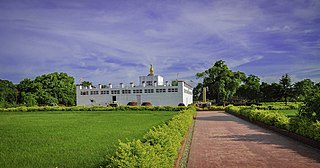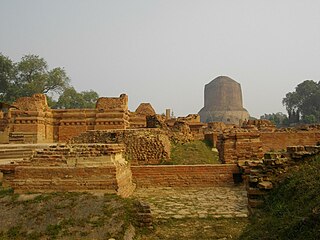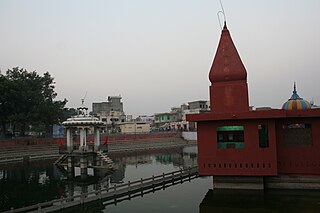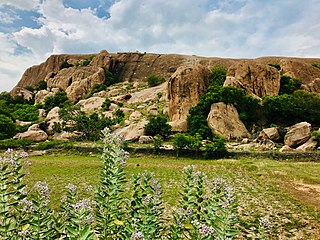
Nalanda was a renowned Buddhist mahavihara in ancient and medieval Magadha, eastern India. Widely considered to be among the greatest centres of learning in the ancient world, and often referred to as "the world's first residential university", it was located near the city of Rajagriha, roughly 90 kilometres (56 mi) southeast of Pataliputra. Operating for almost a thousand years from 427 CE until around 1400 CE, Nalanda played a vital role in promoting the patronage of arts and academics during the 5th and 6th century CE, a period that has since been described as the "Golden Age of India" by scholars.

Lumbinī is a Buddhist pilgrimage site in the Rupandehi District of Lumbini Province in Nepal. According to the sacred texts of the Buddhist Commentaries, Maya Devi gave birth to Siddhartha Gautama in Lumbini in c. 624 BCE. Siddhartha Gautama achieved Enlightenment, and became Shakyamuni Buddha who founded Buddhism. He later passed into parinirvana at the age of 80 years, in c.544 BCE. Lumbini is one of four most sacred pilgrimage sites pivotal in the life of the Buddha.

Sarnath is a town located 8 kilometres northeast of Varanasi, near the confluence of the Ganges and the Varuna rivers in Uttar Pradesh, India. According to the Lalitavistara sutra, the Gautama Buddha chose "Deer Park by the Hill of the Fallen Sages, outside of Varanasi" for the location of his first teachings of Buddhism, known as the Dhammacakkappavattana sutra, after he attained enlightenment at Bodh Gaya. It is one of eight most important pilgrimage sites for Buddhists, and has been nominated to become a UNESCO World Heritage Site.

Mahasthangarh is the earliest urban archaeological sites discovered thus far in Bangladesh. The village Mahasthan in Shibganj upazila of Bogra District contains the remains of an ancient city which was called Pundranagara or Paundravardhanapura in the territory of Pundravardhana. A limestone slab bearing six lines in Prakrit in Brahmi script recording a land grant, discovered in 1931, dates Mahasthangarh to at least the 3rd century BCE. It was an important city under the Maurya Empire. The fortified area of the city was in use until the 8th century CE.

Shravasti is a town in Shravasti district in Indian state of Uttar Pradesh. It was the capital of the ancient Indian kingdom of Kosala and the place where the Buddha lived most after his enlightenment. It is near the Rapti river in the northeastern part of Uttar Pradesh India, close to the Nepalese border.

Mihintale is a mountain peak near Anuradhapura in Sri Lanka. It is believed by Sri Lankans to be the site of a meeting between the Buddhist monk Mahinda and King Devanampiyatissa which inaugurated the presence of Buddhism in Sri Lanka. It is now a pilgrimage site, and the site of several religious monuments and abandoned structures.

Ramateertham is a village panchayat in Nellimarla mandal of Vizianagaram district in Andhra Pradesh in India. It is about 12 km from Vizianagaram city. It is a famous Pilgrimage and also Ancient Historical Site since 3rd Century BCE. There is a post office at Ramateertham. The PIN code is 535218.

Pehowa is a town and a municipal committee in Kurukshetra district in the Indian state of Haryana. It is an important sacred Hindu pilgrimage site, related to Krishna and the Mahabharata, within the 48 Kos Parikrama of Kurukshetra. The Hindu genealogy registers at Peohwa, Haryana are kept there at the Pruthudak Tirath on the banks of Sarasvati river.

Nagarjunakonda is a historical town, now an island located near Nagarjuna Sagar in Palnadu district of the Indian state of Andhra Pradesh. It is one of India's richest Buddhist sites, and now lies almost entirely under the lake created by the Nagarjuna Sagar Dam. With the construction of the dam, the archaeological relics at Nagarjunakonda were submerged, and had to be excavated and transferred to higher land, which has become an island.

Pushpagiri was an ancient Indian mahavihara or monastic complex located atop Langudi Hill in Jajpur district of Odisha, India. Pushpagiri was mentioned in the writings of the Chinese traveller Xuanzang and some other ancient sources. Until the 1990s, it was hypothesised to be one or all of the Lalitgiri-Ratnagiri-Udayagiri group of monastic sites, also located in Jajpur district. These sites contain ruins of many buildings, stupas of various sizes, sculptures, and other artifacts.

Somapura Mahavihara or Paharpur Buddhist Vihara in Paharpur, Badalgachhi, Naogaon, Bangladesh is among the best known Buddhist viharas or monasteries in the Indian Subcontinent and is one of the most important archaeological sites in the country. It was designated as a UNESCO World Heritage Site in 1985. It is one of the most famous examples of architecture in pre-Islamic Bangladesh. It dates from a period to the nearby Halud Vihara and to the Sitakot Vihara in Nawabganj Upazila of Dinajpur District.
Kandarodai is a small hamlet and archaeological site of Chunnakam town, a suburb in Jaffna District, Sri Lanka. The notable ancient Buddhist monastery referred to as Kadurugoda Vihara is situated in Kandarodai.

Nelakondapally, also referred to as Nelakondapalli or Nela Kondapalli, is a town and headquarters of a mandal in Khammam district, Telangana, India. It is also an archaeological site important to early Buddhism and Hinduism, where excavations have discovered a major stupa site near an ancient manmade lake, another site where Buddhist and Hindu artwork were carved in pre-3rd century India, both sites also yielding hundreds of ancient rare coins with Shaiva and Vaishnava inscriptions from the dynasties of Andhra Ikshvakus and Vishnukundinas. Nelakondapally is also the birthplace of Bhakta Ramadasu.

Nekresi is a historic and archaeological site in eastern Georgian region of Kakheti, between the town of Qvareli and the village of Shilda, at the foothills of the Greater Caucasus mountains. It is home to the still-functioning Nekresi monastery, founded in the 6th century.

Shalban Bihar is an archaeological site in Moinamoti, Comilla, Bangladesh. The ruins are in the middle of the Lalmai hills ridge, and these are of a 7th-century Paharpur-style Buddhist Bihar with 115 cells for monks. It operated through the 12th century.

Maya Devi Temple is an ancient Buddhist temple situated at the UNESCO World Heritage Site of Lumbini, Nepal. It is the main temple at Lumbini, a site traditionally considered the birthplace of Gautama Buddha. The temple stands adjacent to a sacred pool and a sacred garden. The archaeological remains at the site were previously dated to the third-century BCE brick buildings constructed by Ashoka. A sixth-century BCE timber shrine was discovered in 2013.

Samanar Hills, also known as Samanar Malai or Amanarmalai or Melmalai, is a rocky stretch of hills located near Keelakuyilkudi village, 10 kilometres (6.2 mi) west of Madurai city, Tamil Nadu, India. They stretch east–west over 3 kilometers towards Muthupatti village. These rocky hillocks are home to many Jain and Hindu monuments. The hill has been declared as a protected monument by the Archaeological Survey of India.

Sirpur Group of Monuments are an archaeological and tourism site containing Hindu, Jain and Buddhist monuments from the 5th to 12th centuries in Mahasamund district of the state of Chhattisgarh, India. Located near an eponymous village, it is 78 kilometres (48 mi) east of Raipur, the capital of the state. The site is spread near the banks of the river Mahanadi.

The Kurkihar hoard is a set of 226 bronzes, mostly Buddhist, dating to between the 9th and 12th centuries CE, which were found in Kurkihar near Gaya in the Indian state of Bihar. The village of Kurkihar is situated about 5 km. north-east of Wazirganj, and 27 km east from Gaya. The inscriptions found suggest that Kurkihar was once a well known international pilgrimage center.
Chandrapur University or Srichandrapur University is a 10th century educational institution and monastery. Srichandra, a ruler of the Chandra dynasty, established it in 935 CE on 20,000 acres (8,100 ha). Efforts by the Archaeological Department of Bangladesh to locate the original ruins are ongoing.



















